Newsletter Items
Autumn 2007
Contents
The annual subscription will now cover the cost of meetings, and has therefore been set at £12.50 per year, due 1 January 2008. The Newsletter article 'Treasurer's Thoughts' explains the necessity for and thinking behind this change.
The Newsletter contains reports on seven of the gardens we visited and there are some descriptions with the photos on the slide show here on the website. The two gardens in Northamptonshire, the Old Vicarage at Sudborough and Coton Manor Gardens, do not have reports, but are included in the slide show.
A short report from Beryl Burton on this day.
We welcomed three new members between the publication of the Spring and Autumn Newsletters.
Fennel, this year's peculiar and dreadful weather and its effects on his plants, clematis, the Hardy Planter's usual problem of space, particular favourites and gap-filling have all entered into Alan Hale's musings.
Leila Mantle's view of the move from Drake's Broughton to Peopleton.
Bev Drewitt's list of garden naughties: her experiences of golden hop, montbretia, geraniums, teasel, red valerian and a rambling rose later found to be 'not recommended for small gardens'.
Judith and Colin Doughty's account of their pleasure in an unplanned visit to the private gardens in these two villages on the eastern edge of Dartmoor.
An old Worcestershire recipe which uses surplus fruits, contributed by Sheila Webster.
The Editor's thoughts on her garden this summer - the star plants, a wonderful combination of plants and a reflection prompted by her visit to Zion National Park in Utah. And she would welcome advice on crambe - please write to her.
The Editor has thanked all those who contributed to this edition and is looking forward to receiving articles about the plants purchased on the East Anglia holiday. She needs contributions for the March edition by 15 February 2008.
Articles
Treasurer's Thoughts
Four months have passed since John gave me the cheque book and an enormous box full of little envelopes to store money in. I got into such a muddle at the first meeting, there seemed to be little bits of money for everything. However, I have endeavoured to introduce a system so I can see what makes money and where the money goes.
I quickly came to share my predecessor's concern about the apparent imbalance between income and expenditure which led to the proposal, following the AGM, to raise the basic sub. to £5. With travel expenses, a speaker now costs approaching £100 and the cost of the hall hire has to be added. Around 40 people attend meetings and pay £1 each, leaving a yawning gap to be financed by the raffle, sale of plants etc. The £2.50 sub covers general administration, Newsletter costs not covered by income from advertisers, including postage.
I also became conscious of the fact that Wendy and Leila are being asked to commit to a programme of speakers up to 18 months in advance whereas the income to cover the expenditure rests on the willingness and ability of members to attend meetings. No manager in business would commit to such a speculative venture.
For this reason the Committee decided to restructure our finances in line with other societies, i.e. the cost of staging the meetings should be built into the basic subscription and there would be no additional charge for attending meetings. This would enable us to plan future events with more confidence and hopefully book one or two "star" speakers. It would also get rid of the queue at the door to come in. Members would only have to tick themselves in (a necessary evil for fire precautions).
Given that there are 11 indoor meetings a year a sub. of £13.50 was suggested (11 meetings @ £1 and £2.50 current basic sub.), It was accepted that with the best will in the world it is difficult to attend all meetings and the Committee approved a figure of £12.50 for the 2008 sub. I accept that those who attend only a few meetings will be penalised, but it is essential that our finances are placed on a sound footing. So please support us by attending meetings and paying your sub on time.
Rebecca Dale
Hereford & Mid-Wales Summer Garden Day
On 16th June 2007, I arranged to meet a friend from Bucks & Oxford Group at Pembridge Village hall near Leominster. The weather was fine and two coaches were to take the Hardy Planters to four gardens during the course of the day. In addition each coach load sat down to a light and tasty lunch provided in the village hall.
All the gardens were different and lovely; two of them, Ivycroft and Aulden Farm, I had visited with our group in 2006, so it was nice to see them again, this time in June.
Congratulations are due to Hereford and mid-Wales Group for their excellent organisation. They provided such a friendly welcome and a most enjoyable day out.
Beryl Burton.
New Members
We have welcomed 3 new members since the last newsletter.
Heather Dale gardens in Cotheridge, Worcester. The house and garden are set in the belt of woodland that protected the old Court on the site. The garden covers about two thirds of an acre and includes mature trees, beds with shrubs and herbaceous plantings as well as a large vegetable garden. Heather has named each of the beds after the friend who donated plants for that bed. The soil is loam/clay and very fertile. Heather is renowned as a compost maker. The greatest challenge is making sure that plants are in the best situation taking into account the shade from the trees.
Rita Carter and Sharon Willis.
Mother and Daughter Rita and Sharon learned about the Worcestershire Group through visiting the Perennial Garden during an Open Day at Pershore College. They garden separately in Bromsgrove. Sharon moved to her current garden 6 years ago. It was very overgrown and Sharon has cleared and replanted it. Both have joined the Group to learn more about perennial plants through the speakers and from other members. They like perennials in particular as "they tend to do what is written on the label". Sharon is particularly keen on the daisy and sunflower families.
Mickleton Musings
Relaxing on the terrace on the last day of July, I found my attention drawn to a quite splendid common green fennel (Foeniculum vulgare), which has inserted itself in the narrow channel between the edge of the grass and the low terrace wall. It is about 4ft high, multi stemmed, with a profusion of mustard yellow blooms and thread-like foliage. Fennel is not considered a choice plant, and I admit I probably wouldn't buy one from the nursery, and yet looking at it, there is no denying it is making a delightful contribution to that part of the garden.
The topsy-turvy weather pattern this year has been even more of a topic of conversation amongst us than usual. After the mild winter, not necessarily a good thing, and the beautiful April, it was all downhill for three miserable months, culminating in four and three quarters inches of rain on 20th of July, and much flooding in the area, although mercifully we were spared the worst.
These un-seasonal months were thoroughly depressing and yet the plants, almost without exception, seem to have positively enjoyed the conditions. The Ligularia przewalskii, which normally looks near to death's door when the sun strikes it, and which I shouldn't really attempt to grow in our freedraining soil, has never looked better, and our clematis collection, now numbering 123, which like a regular drink, have appreciated the regular rainfall. Of course heavy rain and wind can cause havoc in the garden. I am what is known as a 'tidy gardener', derided by the naturalistic brigade, but I make no apologies for staking and tying, hating to see a clump of flowers flattened to the ground, a situation that is hard to retrieve. I use link-stakes together with bamboo canes, and miles of green string, which if put in position early enough, become virtually invisible as the year progresses.
We are just completing our third year at Mickleton, and glancing around, I am amazed at how the garden looks. So much so that I have reached the situation where it is difficult to find a spot for a new plant. This, regrettably, inhibits my purchases at nurseries and plant sales. When going round the edges of the existing beds in the early spring with a half moon tool, I increase the size by two or three inches, but, rather than give me extra planting space, all this does is to encourage the plants in situ to advance forward by the same amount.
Where clematis are concerned, I have dug out a narrow bed along our back fence, festooned it with plastic netting, and this has become home for another 12 of our favourites although it will be another year or two before
they are mature enough to give of their best.
So what plants have performed well this year? As mentioned before most of them seem to have enjoyed the rain, and the pelleted chicken manure I scattered on the beds in spring may have helped. First off, the hepaticas gave their usual jewel-like display, and the dwarf and short-stemmed daffodils were excellent. Easier to place than their taller relatives, many more varieties are now available. I particularly like Sailboat, Hawera and Minnow. The hostas have had a good year, although the slugs and snails have also found the conditions to their liking and I find myself on a permanent war footing.
Two clematis, General Sikorski and Mdm Grange, started well, then became very sick and had to be cut down. They may have been victims of snail attack at ground level. It could have been windburn although most likely it was the dreaded wilt. Who knows? It is always frustrating not knowing the reasons for malaise and death in one's plants. Anyway I treated the area with fungicide, fed them with bone meal and then top-dressed with compost. Hopefully they will shoot again next year.
One early clematis which has been a star is C. mandschurica, which has small white flowers similar to C. recta. It needed supporting but repaid with a splendid display that lasted for weeks. At present (mid August) the Phlox are still looking good also the Veronicastrums, the Gypsophila, the Aster frikartii 'Monch' and the tall Eupatorium atropurpureum, an underrated plant according to the R.H.S.
Another plant worth mentioning, just coming into flower, is Scutellaria incana, with lipped flowers rather like a salvia, in a shade of blue grey. A personal favourite, the climbing Dicentra scandens, which has almost succeeded in hoisting its yellow lockets to the top of our 15 ft fastigiate Irish Yew, has provided pleasure for weeks. Why this climber is not more widely grown, I don't know.
Finally, for filling gaps in the borders I would recommend the Nemesias and Diascias to be found in the Garden Centres early in the year, and often sold for use in patio containers and hanging baskets. They are comparatively undemanding plants and give a wonderful splash of colour which lasts for ages. Although usually treated as annuals they are in fact perennials, and it is worth cutting them back, and leaving them in the ground to see if they survive the winter.
Alan Hale
All Change! - A Personal View
Our first meeting in the new venue at Peopleton was a resounding success with an excellent speaker, Rob Cole ably supported by wife Diane. With several visitors and more members than usual present there was a real buzz in the hall. The kitchen facilities were excellent even though the cricket teas were being prepared at the same time as our refreshments, and there was the added bonus of a half-naked man in the kitchen!
The Donated Plants table was well supported and the speakers brought a good selection of plants with them. It was sad not to see the happy faces of Kate and Liz manning a table and giving advice with their usual patience. This I assume is due to the committee's decision only to have invited nurseries when speakers do not bring plants. I do hope these founder members have not been dissuaded from coming to our meetings.
Leila Mantle
Thugs I Have Loved
No, not my life as a gangster's moll (I'll write about that another time) but a list of plants I love but which love me too well. Golden hop (Humulus lupulls 'Aurea'). Bought to brighten up and hide the back fence but after it had rampaged for several years over its neighbouring climbing roses and honeysuckle, it had to go. It didn't have lovely bunches of hops either as a compensation; I must have picked a male plant. When we came to dig it up we found it had insinuated its roots for yards and yards between the earth and a membrane we had laid at the top of the garden. It was like pulling rope out (and as tough)!
Montbretia (Croscosmia x croscomiiflora): Everyone has this, don't they, and I admit it's reasonably easy to pull out. However I spent a happy hour digging corms out from round a fuchsia root and still didn't get them all. In its favour it makes a good show at the end of summer as other things go over.
Geraniums: I love these plants; they're easy to grow and trouble free but this year G.thurstonianum has romped over everything around it. `A.T. Johnson' has done the same and it seeds as well. Pride of place must go to `Bill Wallis' however. I was told it would seed around and does it! I now have a lawn full of its seedlings and they're popping up in all sorts of other places.
Teasel (Dipsacus fullonum): Such a good architectural plant and it attracts goldfinches as well but another horrendous seeder. I must have pulled out literally hundreds of its babies this year and there are still hundreds more to come. I reckon every seed must germinate.
Red valerian (Centranthus ruber): is a good bee plant but another seed horror. From one planted three years ago I now have loads in unexpected places.
Rambling rose `Wedding Day': Bought to climb over a lilac tree and provide interest after the lilac had flowered, it has colonised the neighbouring holly tree as well as throwing out long prickly shoots which wave about in the wind and catch on your jumper when you're trying to garden near it. Recently I read a book which said `Not recommended for small gardens.' If only I'd seen that first!
So, that's my list of garden naughties. I expect everyone could add more to it and will.
Bev Drewitt
The secret gardens of Ilsington and Haytor Vale
View
slide show or click on an image to enlarge it
'Are you here for the gardens?' 'Well, yes, but we're a bit early.' 'Doesn't matter - I'll sell you maps - I'm one of the organisers, Ann. You can miss out the muddle at the hall. Trumpeter would be a good place to start.' Ilsington and Haytor Vale are on the eastern edge of Dartmoor about three miles from Bovey Tracy. Just under Haytor Rocks, Haytor Vale is at about 300 metres. Ilsington, 100 metres lower, has a hotel, shop, church, village hall, sheltered housing, pub - and primary school. The gardens were open to raise funds for the school. We'd seen the banner as we arrived the previous evening. Equipped with maps (15 gardens in all) we put on our boots and set off.
The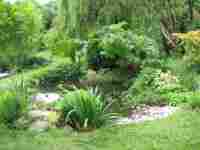 garden at 'Willowbrook', Trumpeter rises behind the house. Trees and irregular-shaped lawn merge into bigger trees and fields beyond - a rabbit was eating daisies in the lawn. There is a slightly more formal area near the house, a greenhouse and some new raised vegetable beds. This being Dartmoor in May, azaleas and rhododendrons were in flower. But the prettiest feature is the response to the garden being riddled with springs which appear unexpectedly. The water is led via small natural-looking streams to a pond planted with, among others, hostas, Gunnera manicata, Caltha palustris, Iris pseudacorus, libertia and various grasses. Sedum spectabile and delphiniums were there for later in the season and ajuga filled in. The plants are not unusual, but look well-grown and sturdy in this almost completely organic garden.
garden at 'Willowbrook', Trumpeter rises behind the house. Trees and irregular-shaped lawn merge into bigger trees and fields beyond - a rabbit was eating daisies in the lawn. There is a slightly more formal area near the house, a greenhouse and some new raised vegetable beds. This being Dartmoor in May, azaleas and rhododendrons were in flower. But the prettiest feature is the response to the garden being riddled with springs which appear unexpectedly. The water is led via small natural-looking streams to a pond planted with, among others, hostas, Gunnera manicata, Caltha palustris, Iris pseudacorus, libertia and various grasses. Sedum spectabile and delphiniums were there for later in the season and ajuga filled in. The plants are not unusual, but look well-grown and sturdy in this almost completely organic garden.
After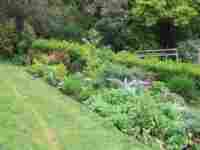 talking to us about their garden the owners gave us directions, over fields and through a very fine wood, to Haytor Vale, where the first garden is on slope that neither of us would like to tackle. The terracing is informal and grass slopes between the levels. Some plants were the same as those at Trumpeter, but cardoons, alliums and heuchera looked happy; hemerocallis would provide a good show later and a superb Euphorbia griffithii 'Fireglow' was a real star near dark shrubs.
talking to us about their garden the owners gave us directions, over fields and through a very fine wood, to Haytor Vale, where the first garden is on slope that neither of us would like to tackle. The terracing is informal and grass slopes between the levels. Some plants were the same as those at Trumpeter, but cardoons, alliums and heuchera looked happy; hemerocallis would provide a good show later and a superb Euphorbia griffithii 'Fireglow' was a real star near dark shrubs.
A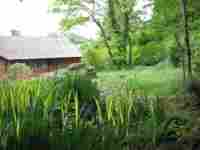 garden in a wood followed - the owners' main interest is native trees, but their azaleas near the house were brilliant despite the short, heavy 'shower'. We sheltered in the summerhouse and were offered - and gratefully accepted - a cup of tea and home-made biscuit.
garden in a wood followed - the owners' main interest is native trees, but their azaleas near the house were brilliant despite the short, heavy 'shower'. We sheltered in the summerhouse and were offered - and gratefully accepted - a cup of tea and home-made biscuit. The long, narrow gardens opposite the row of miners' cottages added centaurea, Geranium macrorrhizum, Clematis montana, syringa and peonies to the plants we'd seen -Iris sibirica, aquilegia and azaleas were in all the gardens.
The long, narrow gardens opposite the row of miners' cottages added centaurea, Geranium macrorrhizum, Clematis montana, syringa and peonies to the plants we'd seen -Iris sibirica, aquilegia and azaleas were in all the gardens.
At

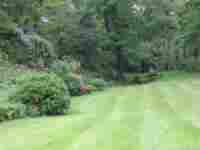 Pinchaford farmhouse, deep in a combe, deer do not allow perennials, but the banks of azaleas, rhododendrons, pieris and skimmia were superb. A narrow, gently-sloping path under trees and between rocks up into the combe is a lovely small example of a 'landscape garden'. And we hope our advice on deer not liking shrubby potentillas and on pruning the magnificent wisteria will be useful.
Pinchaford farmhouse, deep in a combe, deer do not allow perennials, but the banks of azaleas, rhododendrons, pieris and skimmia were superb. A narrow, gently-sloping path under trees and between rocks up into the combe is a lovely small example of a 'landscape garden'. And we hope our advice on deer not liking shrubby potentillas and on pruning the magnificent wisteria will be useful.
After a 'break' for a couple of hours' walking in the late afternoon sun at Haytor Rocks, and a trip in a downpour next day to Burnham Nurseries, orchid specialists near Newton Abbot,
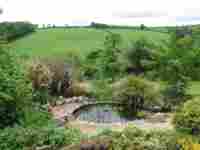 we were back in Ilsington, where Ann's solution to the water and slope is two ponds - one quite formal, and one for wildlife, with an underground water tank between them. The garden is evolving away from her children's needs, to one for everyone to 'live in' - sitting areas with views over the hills, a small 'copse' where the swing used to be, odd but quite jolly small metal sculptures. To the usual rollcall of plants were added cordylines, Acer palmatum, lots of different grasses and a watsonia, with which she is very pleased. As our front 'lawn' is in need of a rethink, we were interested in the very short thyme between paving, and other low plants growing well in sunny places.
we were back in Ilsington, where Ann's solution to the water and slope is two ponds - one quite formal, and one for wildlife, with an underground water tank between them. The garden is evolving away from her children's needs, to one for everyone to 'live in' - sitting areas with views over the hills, a small 'copse' where the swing used to be, odd but quite jolly small metal sculptures. To the usual rollcall of plants were added cordylines, Acer palmatum, lots of different grasses and a watsonia, with which she is very pleased. As our front 'lawn' is in need of a rethink, we were interested in the very short thyme between paving, and other low plants growing well in sunny places.
The
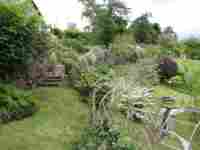 family at Portland Villa is perched on the steepest slope we saw, with the inevitable stream. Solution - formal terracing with roses (some over a small pergola), Pyrus salicifolia 'Pendula', Felicia petiolata and creeping plants near the house, with the stream kept underground to emerge into a small formal canal. It is then allowed out into a pond, stream and wildlife pond before taking itself off out of the garden. The lower, informal area is grass and shrubs, including a magnificent Viburnum plicatum 'Mariesii .
family at Portland Villa is perched on the steepest slope we saw, with the inevitable stream. Solution - formal terracing with roses (some over a small pergola), Pyrus salicifolia 'Pendula', Felicia petiolata and creeping plants near the house, with the stream kept underground to emerge into a small formal canal. It is then allowed out into a pond, stream and wildlife pond before taking itself off out of the garden. The lower, informal area is grass and shrubs, including a magnificent Viburnum plicatum 'Mariesii .
The

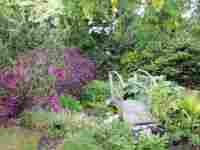 most secret of the gardens, right in the village, is through a little yard with canaries and rabbits in hutches. A blue clematis and yellow rose give onto a view of laburnum. The surprise is the plants grown from seed brought back from a Caribbean holiday - including a banana with a flower spike. It is surrounded by hostas, phormium, cordyline and Trachycarpus fortunei. Architectural shapes of Iris sibirica, Acer palmatum, rheum, more trachycarpus and a dwarf pine, surround the pond here. And the large vegetable patch and fruit cage, beyond a hedge, are another surprise.
most secret of the gardens, right in the village, is through a little yard with canaries and rabbits in hutches. A blue clematis and yellow rose give onto a view of laburnum. The surprise is the plants grown from seed brought back from a Caribbean holiday - including a banana with a flower spike. It is surrounded by hostas, phormium, cordyline and Trachycarpus fortunei. Architectural shapes of Iris sibirica, Acer palmatum, rheum, more trachycarpus and a dwarf pine, surround the pond here. And the large vegetable patch and fruit cage, beyond a hedge, are another surprise.
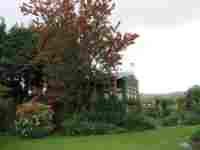
Further up on the moor bamboo and Embothrium coccineum grow in an otherwise quite traditional cottage garden.
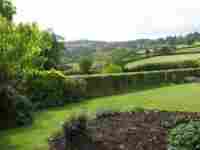 More superb views, this time of Haytor Rocks, are behind the house whose main garden, the last we visited, is being remodelled. But the vegetable garden is in excellent order, as is the wisteria trained in almost military fashion against the end wall of the house.
More superb views, this time of Haytor Rocks, are behind the house whose main garden, the last we visited, is being remodelled. But the vegetable garden is in excellent order, as is the wisteria trained in almost military fashion against the end wall of the house. Clematis montana over the wall and across the driveway gate, opened and shut for the car, has escaped such discipline - magnificent.
Clematis montana over the wall and across the driveway gate, opened and shut for the car, has escaped such discipline - magnificent.
We had stayed at the hotel in Ilsington three times before, always going out of it to walk on the moor or to the coast. We had had no idea of the extraordinary wealth of gardens, plants and gardening knowledge in and round it. Very few of the plants are particularly unusual, but are used to best effect in gardens which are not by any means 'show gardens', most of which are on very difficult terrain. On a weekend when the Ten Tors Challenge was called off due to dreadful weather, such gardens were a godsend. On Monday, the rain stopped, the wind lessened and the sun came out, and we found a new and very satisfactory walk in fields, lanes and woods.
Judith Doughty, June 2007
High Dumpsy Dearie Jam
This is an intriguing name for an old Worcestershire recipe, which uses surplus fruits (but no metric measures!)
2lbs Cooking apples, preferably Bramleys - peeled and cored
2lbs Pears - peeled and cored
2lbs Plums - halved and stoned
Juice and grated rind of 1 lemon
Bruised root of dried ginger
4 1/2 lbs sugar
Water
Place all fruit in a heavy-based pan and add just enough water to cover the base. Simmer until tender - about 40-45 mins. Remove from the heat, add sugar - stirring until dissolved. Add lemon juice and grated rind and ginger root. Bring to the boil and cook rapidly for about 15 minutes, until setting point is reached. Remove root and pot and seal the jam. Makes about 7lbs.
Sheila Webster
How can I encourage Crambe to Flower?
It has been a strange summer in the garden. Many plants have excelled whilst others seem to have "sulked". I have enjoyed the flowers on Cirsium rivulare 'Atropurpureum' and Geranium 'Patricia' uninterrupted for five and a half months and both are still in flower as I write this in mid October. Psoralia bituminosa threaten to take over in places. It is a native plant of Crete with soft grey foliage and lilac/blue vetch like flowers. Its common name is pitch trefoil. I bought it several years ago from Stone House Cottage Gardens and, on advice that it might not be entirely hardy, took cuttings. The main plant died during its first winter but the plants from cuttings survived outside last winter. The warm weather we had in April really got it growing and the wet months that followed seemed to be ideal for it. Whereas in other years it has looked good in the border where it was planted, this year it has sent out long stems and looked even better. It is just that it is not planted in the right place for the extent of its growth this year.
Crambe cordifolia has not fared so well. I have two plants, one in full sun and another in partial shade. They have flowered for 2 years, but not this one. The leaves of one of them are useful, covering and disguising the pond filtration equipment, even if a bit untidy at times. However, without flowers I am not sure that it is a star plant! Are they "iffy" or has it just been the weather conditions? Please write to me!
My favourite plant combination this summer has been Geranium Rozanne and a nepeta (I cannot remember which one) with Verbena "Homestead Purple" and Stacys byzantina "Big Ears" alongside. They have been in flower for months and alive with bees all day, every day. The activity is mesmerising and I must place a seat nearby.
All these are coming to the end of their flowering season and already Lonicera x purpusii and Jasminum nudiflorum are in flower for the winter. I am also enjoying the flowers on three cyclamen that I won in the raffle at the meeting in September 2006. We are picking and enjoying strawberries, out of doors! What a topsy turvey year!
Over the last few weeks we have had another trip to USA. This time we had the pleasure of seeing desert plants such as Yucca and Prickly Pears growing within a few feet of damp and shade loving Adiantum. It is all in the micro climates of Zion National Park in Utah. The desert plants were growing on the open hillside whilst the fern was under an overhanging rock with water seeping from the point where the overlying sandstone met the underlying impervious rock. A lesson for us all!
Vivienne McGhee
From the Editor
Thank you to all who have written for this edition of the Newsletter and to Jenny Constant for the front cover drawing. The East Anglia Tour got you writing. The gardens clearly were inspirational and I hope that those of you who went on the tour will enjoy the memories that the articles evoke. With all the tales of the numbers of plants purchased and the packing of the coach, I am looking forward to articles about the plants that were purchased, where they have been planted and how they are doing. I would also like to receive the occasional digital photograph for inclusion in the next edition. I hope that the articles will tempt others to visit the gardens themselves or to book for the next tour.
The next edition will be available at the March meeting. I need to have contributions by Friday 15 February 2008, at meetings, by email or by post at Half Acre, Main Street, Aldington, WR11 7XB.
Vivienne McGhee
 garden at 'Willowbrook', Trumpeter rises behind the house. Trees and irregular-shaped lawn merge into bigger trees and fields beyond - a rabbit was eating daisies in the lawn. There is a slightly more formal area near the house, a greenhouse and some new raised vegetable beds. This being Dartmoor in May, azaleas and rhododendrons were in flower. But the prettiest feature is the response to the garden being riddled with springs which appear unexpectedly. The water is led via small natural-looking streams to a pond planted with, among others, hostas, Gunnera manicata, Caltha palustris, Iris pseudacorus, libertia and various grasses. Sedum spectabile and delphiniums were there for later in the season and ajuga filled in. The plants are not unusual, but look well-grown and sturdy in this almost completely organic garden.
garden at 'Willowbrook', Trumpeter rises behind the house. Trees and irregular-shaped lawn merge into bigger trees and fields beyond - a rabbit was eating daisies in the lawn. There is a slightly more formal area near the house, a greenhouse and some new raised vegetable beds. This being Dartmoor in May, azaleas and rhododendrons were in flower. But the prettiest feature is the response to the garden being riddled with springs which appear unexpectedly. The water is led via small natural-looking streams to a pond planted with, among others, hostas, Gunnera manicata, Caltha palustris, Iris pseudacorus, libertia and various grasses. Sedum spectabile and delphiniums were there for later in the season and ajuga filled in. The plants are not unusual, but look well-grown and sturdy in this almost completely organic garden.
 talking to us about their garden the owners gave us directions, over fields and through a very fine wood, to Haytor Vale, where the first garden is on slope that neither of us would like to tackle. The terracing is informal and grass slopes between the levels. Some plants were the same as those at Trumpeter, but cardoons, alliums and heuchera looked happy; hemerocallis would provide a good show later and a superb Euphorbia griffithii 'Fireglow' was a real star near dark shrubs.
talking to us about their garden the owners gave us directions, over fields and through a very fine wood, to Haytor Vale, where the first garden is on slope that neither of us would like to tackle. The terracing is informal and grass slopes between the levels. Some plants were the same as those at Trumpeter, but cardoons, alliums and heuchera looked happy; hemerocallis would provide a good show later and a superb Euphorbia griffithii 'Fireglow' was a real star near dark shrubs.
 garden in a wood followed - the owners' main interest is native trees, but their azaleas near the house were brilliant despite the short, heavy 'shower'. We sheltered in the summerhouse and were offered - and gratefully accepted - a cup of tea and home-made biscuit.
garden in a wood followed - the owners' main interest is native trees, but their azaleas near the house were brilliant despite the short, heavy 'shower'. We sheltered in the summerhouse and were offered - and gratefully accepted - a cup of tea and home-made biscuit. The long, narrow gardens opposite the row of miners' cottages added centaurea, Geranium macrorrhizum, Clematis montana, syringa and peonies to the plants we'd seen -Iris sibirica, aquilegia and azaleas were in all the gardens.
The long, narrow gardens opposite the row of miners' cottages added centaurea, Geranium macrorrhizum, Clematis montana, syringa and peonies to the plants we'd seen -Iris sibirica, aquilegia and azaleas were in all the gardens.
 Pinchaford farmhouse, deep in a combe, deer do not allow perennials, but the banks of azaleas, rhododendrons, pieris and skimmia were superb. A narrow, gently-sloping path under trees and between rocks up into the combe is a lovely small example of a 'landscape garden'. And we hope our advice on deer not liking shrubby potentillas and on pruning the magnificent wisteria will be useful.
Pinchaford farmhouse, deep in a combe, deer do not allow perennials, but the banks of azaleas, rhododendrons, pieris and skimmia were superb. A narrow, gently-sloping path under trees and between rocks up into the combe is a lovely small example of a 'landscape garden'. And we hope our advice on deer not liking shrubby potentillas and on pruning the magnificent wisteria will be useful.
 we were back in Ilsington, where Ann's solution to the water and slope is two ponds - one quite formal, and one for wildlife, with an underground water tank between them. The garden is evolving away from her children's needs, to one for everyone to 'live in' - sitting areas with views over the hills, a small 'copse' where the swing used to be, odd but quite jolly small metal sculptures. To the usual rollcall of plants were added cordylines, Acer palmatum, lots of different grasses and a watsonia, with which she is very pleased. As our front 'lawn' is in need of a rethink, we were interested in the very short thyme between paving, and other low plants growing well in sunny places.
we were back in Ilsington, where Ann's solution to the water and slope is two ponds - one quite formal, and one for wildlife, with an underground water tank between them. The garden is evolving away from her children's needs, to one for everyone to 'live in' - sitting areas with views over the hills, a small 'copse' where the swing used to be, odd but quite jolly small metal sculptures. To the usual rollcall of plants were added cordylines, Acer palmatum, lots of different grasses and a watsonia, with which she is very pleased. As our front 'lawn' is in need of a rethink, we were interested in the very short thyme between paving, and other low plants growing well in sunny places.
 family at Portland Villa is perched on the steepest slope we saw, with the inevitable stream. Solution - formal terracing with roses (some over a small pergola), Pyrus salicifolia 'Pendula', Felicia petiolata and creeping plants near the house, with the stream kept underground to emerge into a small formal canal. It is then allowed out into a pond, stream and wildlife pond before taking itself off out of the garden. The lower, informal area is grass and shrubs, including a magnificent Viburnum plicatum 'Mariesii .
family at Portland Villa is perched on the steepest slope we saw, with the inevitable stream. Solution - formal terracing with roses (some over a small pergola), Pyrus salicifolia 'Pendula', Felicia petiolata and creeping plants near the house, with the stream kept underground to emerge into a small formal canal. It is then allowed out into a pond, stream and wildlife pond before taking itself off out of the garden. The lower, informal area is grass and shrubs, including a magnificent Viburnum plicatum 'Mariesii .

 most secret of the gardens, right in the village, is through a little yard with canaries and rabbits in hutches. A blue clematis and yellow rose give onto a view of laburnum. The surprise is the plants grown from seed brought back from a Caribbean holiday - including a banana with a flower spike. It is surrounded by hostas, phormium, cordyline and Trachycarpus fortunei. Architectural shapes of Iris sibirica, Acer palmatum, rheum, more trachycarpus and a dwarf pine, surround the pond here. And the large vegetable patch and fruit cage, beyond a hedge, are another surprise.
most secret of the gardens, right in the village, is through a little yard with canaries and rabbits in hutches. A blue clematis and yellow rose give onto a view of laburnum. The surprise is the plants grown from seed brought back from a Caribbean holiday - including a banana with a flower spike. It is surrounded by hostas, phormium, cordyline and Trachycarpus fortunei. Architectural shapes of Iris sibirica, Acer palmatum, rheum, more trachycarpus and a dwarf pine, surround the pond here. And the large vegetable patch and fruit cage, beyond a hedge, are another surprise.
 More superb views, this time of Haytor Rocks, are behind the house whose main garden, the last we visited, is being remodelled. But the vegetable garden is in excellent order, as is the wisteria trained in almost military fashion against the end wall of the house.
More superb views, this time of Haytor Rocks, are behind the house whose main garden, the last we visited, is being remodelled. But the vegetable garden is in excellent order, as is the wisteria trained in almost military fashion against the end wall of the house. Clematis montana over the wall and across the driveway gate, opened and shut for the car, has escaped such discipline - magnificent.
Clematis montana over the wall and across the driveway gate, opened and shut for the car, has escaped such discipline - magnificent.